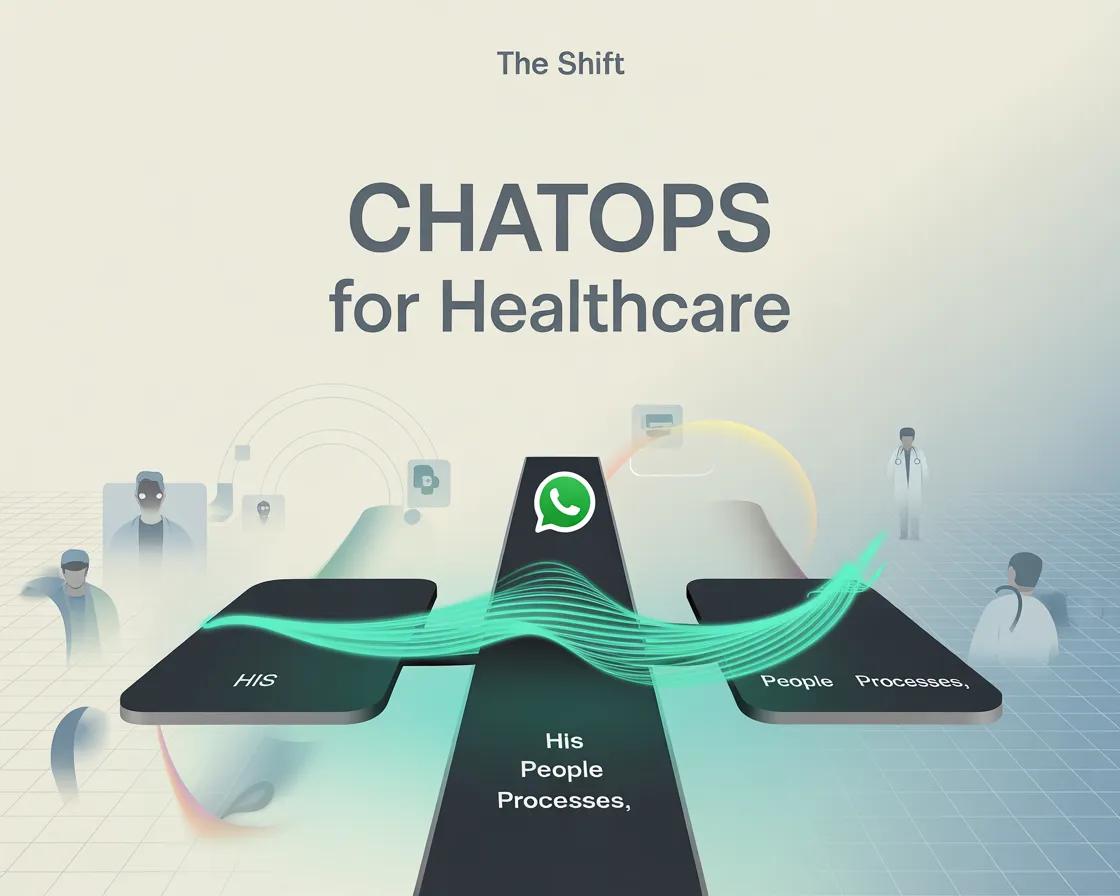The Silent 80%: Where HIS Doesn’t Reach
11/13/2025
Walk into any modern hospital and you’ll see two realities living side-by-side.
On one screen, a Hospital Information System (HIS) captures admissions, billing, diagnostics, and patient history.
On the other side — in WhatsApp groups, phone calls, and paper registers — the real operations unfold: a nurse chasing a bed clearance, a coordinator following up on billing, an anesthetist waiting for confirmation.
Despite years of digitization, around 80 percent of hospital work still happens outside the HIS.
This isn’t because HIS systems failed.
It’s because hospital operations evolve faster than the systems that were built to run them.
Where the System Stops
IS platforms were designed to record transactions — not to orchestrate actions.
They excel at compliance, audit trails, and structured data. But hospitals are living systems, not static workflows.
Clinical and operational teams constantly adapt: new SOPs, emergent cases, staff rotations, seasonal patient surges.
Each change demands immediate coordination that no static form or menu can keep up with.
When that happens, teams revert to what’s fastest — a call, a message, or a quick note.
That’s how the invisible 80 percent is born: work that exists, but never enters the system of record.
Research from Frontiers in Public Health (2022) shows that hospital staff face constant workflow interruptions and task switching — leading to fragmented documentation and lost traceability. Another study on HIS “design-reality gaps” found that when system logic diverges from on-ground practice, staff quietly route work around it instead of through it.
Digitization didn’t fail; it just stopped before the frontline.
The Operational Cost of the Invisible 80%
When work moves outside HIS, three things are lost immediately:
- Speed – Each manual step adds latency. A discharge delayed by two phone calls can extend bed occupancy by half a day.
- Accountability – Tasks are completed, but responsibility blurs. No timestamps, no ownership trail.
- Visibility – Leadership sees reports, not real-time operations. Dashboards reflect history, not now.
The result: COOs and administrators struggle to understand where bottlenecks occur, who is stuck, and why KPIs drift.
The hospital becomes data-rich but action-poor.
A 2023 review on hospital efficiency in Health Informatics Journal notes that untracked coordination time — calls, reminders, informal escalation — can account for 15–25 % of total staff effort.
That’s the hidden drain sitting inside the 80 percent.
Why HIS Alone Can’t Solve It
From a technology standpoint, HIS architectures are optimized for transactional integrity, not adaptive workflows.
Adding each new process or rule requires customization, QA, and release cycles.
That’s essential for stability — but deadly for agility.
From an organizational standpoint, the IT team often sits between operations and vendors. Every change request competes with dozens of others.
The frontline can’t wait. They find their own shortcuts — messages, spreadsheets, screenshots — just to keep the day moving.
It’s not resistance to systems; it’s survival.
The Missing Layer: A System of Action
Hospitals don’t need another system. They need a layer that connects what they already have — HIS, people, and processes — into real-time action.
That’s where ChatOps for Healthcare comes in.
It turns existing communication channels (like WhatsApp) into structured workflows:
- Tasks auto-assigned when HIS events trigger.
- Responses tracked and escalated.
- Closures written back into HIS automatically.
No new logins, no extra dashboards.
Just operational clarity flowing through the tools staff already use.
It transforms WhatsApp from communication into coordination.
A Simple Example: Discharge Delay
- HIS detects a discharge request pending for > 2 hours.
- ChatOps triggers an automated WhatsApp flow to ward and billing staff.
- Responses are timestamped and tracked.
- If no response in 10 minutes, the issue auto-escalates to nursing admin.
- Once cleared, status updates are pushed back into HIS.
Result: faster discharge, reduced bed idle time, measurable ROI — without changing the HIS itself.
This is not messaging. It’s workflow orchestration, living on WhatsApp, powered by data from HIS.
Why HIS Vendors Should Care
This is not a threat to HIS — it’s its natural evolution.
| HIS Strength | ChatOps Addition | Combined Outcome |
| Records and stores data | Routes, tracks, and closes actions | Full operational visibility |
| Built for compliance | Built for adaptability | Control + agility |
| Used mainly by 20% of workforce | Used daily by operations / frontline | Broader engagement |
| One time deployment | Stickier client relationship | Stickier client relationship |
By integrating ChatOps, HIS vendors instantly gain:
- Higher daily relevance to COOs and frontline teams.
- New revenue streams through value-added operational modules.
- Shorter implementation cycles (no heavy dev needed).
- Differentiation from legacy competitors stuck at the record layer.
In short: HIS + ChatOps makes the system live again.
The Path Forward: From Data to Action
The first wave of digitization — HIS, EMR, ERP — captured data.
The next wave is about connecting data to decisions.
Hospitals that link their HIS to a real-time system of action will:
- Respond faster,
- Operate leaner,
- And finally see measurable ROI on years of digitization effort.
That’s not a new system. It’s the missing connection between systems and people.
Closing Thought
If HIS digitized the record of care,
ChatOps digitizes the act of care.
Together, they close the loop between information and action —
and that’s how the silent 80 percent finally becomes visible.
Author:
Prasanna K Ram
Founder-CEO
BizMagnets - ChatOps for Healthcare
